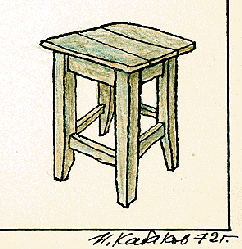ART IN MOSCOW
A Review of the Ilya Kabakov Retrospectives:
'Album Graphics' at the Institute of Contemporary Art
and 'Taboo' at Red Art Gallery
by Serge Khripoun

Ilya Kabakov.
'Stool'. 1973.
The first show, March 25, was organized by Joseph Bakstein, Kabakov's old friend, loyal disciple, and director of local Institute of Contemporary Art. Funny thing is that the ICA office and exhibition hall - where the show happened - use the space of Kabakov's original studio--the old attic. Titled 'Ilya Kabakov. Album Graphics 1971-1974' the exhibit was made in strict accordance to the title: sheets from the album placed on white walls. Nothing more--just the first solo exhibit of Ilya Kabakov, at least since 1989 since he went to the West. The second show, March 28, was much more interesting. It opened at Red Art Gallery (director Petr Plavinsky), in collaboration with XL Gallery and Boris Belsky, director of the Moscow Studio and a collector. It's title - 'Taboo' - is derived from a Russian word for 'stool' (sounds like 'tabooretka'), and it mocks the long suffered 'Oedipus complex' of Moscow's contemporary art scene toward it's 'father'--Kabakov.
The 'Stool' drawing, made in 1972, is the exhibit's central object. Since then Kabakov has done dozens, if not hundreds, of 'stools' - drawings and lithos. Two 'clones'- a bigger one, with some typical Kabakov's textual 'banality', and a small color print that mimicks the famous weird Aeroflot advertising 'Fly by Stools' - are used just to stress the 'industrial productivity' aesthetic of this Russian classic. To emphasize the peculiarity of Kabakov's drawing technique - which thoroughly imitates some 'typical Soviet' book illustration and blueprint handwriting - organizers placed a selection of schemes 'How to make a stool' made in the late 60-ies by some unknown technical student. These drawings serve as, and really look like, the 'originals' of Kabakov's piece. So the 'Taboo' show is basically a trick on the Moscow art scent, compared to deadly serious 'Album Graphics' at ICA.
And the attic - yes, again attic - where 'Taboo' was shown is much more like Kabakov's attic at the time when he worked there: a gloomy space, with bare-brick walls, and no proper floor. It fits into the concept of taking the viewer back to the 'good old days' of Brezhnev era. As Elena Selina, curator of the exhibit, wonders in her essay: "We've been waiting for Ilya Kabakov--so long, and we've been thinking about his work so much, and we're so very aware of his 'parental' influence on Moscow art. So while his arrival has been delayed--what else could we do besides imitation and fetishism?"
Both exhibits gathered almost all the Moscow art community and it has become the hot topic to deal with. Though no rumours have been heard about Kabakov heading home. Ironically, now that the iron curtain has been gone for almost a decade, he still remains a Moscow artist that is only to be shown 'abroad'...
Serge Khripoun
Email: ThingReviews
To post a response fill out the following form and click the "Submit" button. Or go back...
Scroll down to read messages.
Jonas Lindberg -- jani@ekonans.se
Responds:
Kabakov is the greatest. His transmissions are unbeatable. I hope he stays Exile forever. Take it easy
--
Responds:
